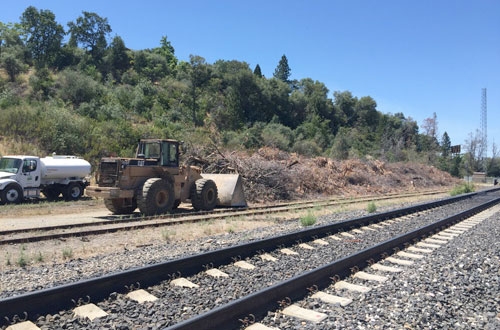UP’s California vegetation management efforts aimed at mitigating fire risk
Written by Jenifer Nunez, assistant editor
Union Pacific is working with hundreds of local, municipal and volunteer fire departments in California to prevent fires along its right-of-way following four years of drought.
“This year, more than three times the average number of fires have been reported in California,” said Mark Mahoney, Union Pacific manager of public projects Western Region.
Union Pacific says it has put controls in place to decrease the number associated with the railroad.
The railroad says overhanging trees, dried native grasses and needles dropped by the state’s famous towering confers can turn into a fuel source, which is why UP is working on creating a 70-foot wide firebreak centered on its main track between Rocklin and Soda Springs.
“Chemicals may be the most cost-effective way to treat overgrowth on the right-of-way,” said MaryBeth Farley, program manager vegetation, “but it’s not the most environmentally friendly.”
Sometimes the efforts to reduce fire possibilities come from unexpected sources, the railroad says. UP recently invested in a snowblower to remove pine needles and debris from between crossties, which reduces the opportunity for spot fires. Additionally, the railroad signed a contract to put goats to work along the right-of-way to help clear dry vegetation.
“Vegetation clearance isn’t always well received,” said Tom Savage, manager-engineering operations support Western Region. “People get used to the big trees along the right of way. It blocks the noise and view of the trains, but that need to eliminate the fuel source is important.”
Regionally, an estimated $20 million annually is spent on vegetation control, with two-thirds going to spraying weeds. In Northern California, the site of heavy vegetation, a current fire prevention project in the Donner Pass area is focused on 80 miles of the highest fire concentration. The project will clear the right-of-way of all grasses, bush and debris and woody material will be chipped on site and donated to the Rocklin Power Plant, where it can be used as a fuel source for the city.
“This is the biggest clearing project we’ve ever done,” Farley said. “The vegetation and dry conditions were getting too close to the Roseville Subdivision and addressing the situation couldn’t wait any longer. There may be risk everywhere, but the goal is to prioritize and implement control measures where there’s a need, before it’s too late.”
The railroad is also adding additional precautions when it comes to routine maintenance activities, such as grinding and welding that can produce fountains of sparks. UP performs the work in an enclosed work area with a surrounding fireproof tent. Spark shields are used and crews are required to have fire-fighting equipment and water on hand. They also must remain in the area of hot work for at least one hour after work has been completed, to ensure they are leaving a safe environment.
“Over the [p]ast 20 years, we’ve worked to perfect a fire-prevention process,” Dave Wickersham, Union Pacific chief engineer-Maintenance of Way said. “All railroad crews are required to take fire prevention training. Before any welding or hot work can take place, the welder must complete a fire risk assessment, which takes into consideration 13 variables, to establish the level of risk. This process has been validated by external fire consultants and CalFire.”





